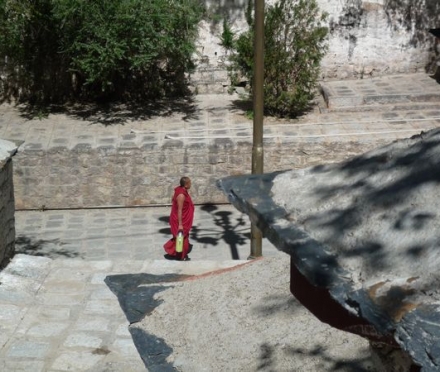
September 14, 2009
The morning after our arrival to Lhasa, a very important meeting was scheduled with representatives of the TAR (Tibetan Autonomous Region) to discuss economic and social policies in Tibet.
They were all there, the Commissions and Departments of all policy fields were represented: development and reform, commerce, education, culture, poverty alleviation, health, environmental protection, ethnic and religious affairs, cultural heritage.
Chaired by vice-president Ying Jin (who is also president of the regional Trade Union), the two hours meeting was made harder by the hot sun which was entering the very nice room of the TAR offices…
The main speech, covering comprehensively as many aspects as possible of the several economic and social issues under discussion, was given by the Minister for development and reform Commission: he talked for about 45 minutes, with basically no interruptions (except for the interpretation time!), and it was entirely based on giving quantitative data on the economic plans implemented in Tibet by the Chinese government.
We all found it too long, especially considering that a dossier was available for us on the table with reference to most of the data and plans mentioned in the Minister’s speech.
But we were determined and keen in asking questions.
One of my key questions was: starting from the assumption that the Chinese government has made an impressive amount of investments in Tibet (particularly in infrastructures and social security subsidies), what is the model of development that you have in mind to make Tibetan economy autonomous at one point, and when do you think that Tibetan economy will actually be able to stand on its own?
The answer was very general and pointed out on the high level of effort undertaken by the Chinese government for the economic development of Tibet, mainly in quantitative and not in qualitative terms. Part of the answer was given directly by Chairman Ying Jin, who stressed the fact that, being Tibet one of the “poorest and backwards regions of China, this preferential policy by the Chinese government would certainly be a long-term one”.
In real terms, Tibetan economy stands on its own for 30%, while 70% is made of payments transfer from the Chinese government. Despite the local leaders insist on the fact that the private initiative is more and more encouraged, from what I could see during these few days, that is not extremely visible, except for the many small shops that characterise the city and which are in most cases owned by Han people.
Other questions and issues underlined by our Delegation regarded the problems of extreme discrepancies existing between urban and rural areas, as well as the topic of possible insufficient training of the Tibetan workforce and the scope of health insurance system.
On all issues, the officials of the TAR claimed that Tibet is facing an encouraging situation: the gap between rural and urban areas is narrowing substantially; all enterprises are implementing training schemes for their workforce, all Tibetans are covered by health insurance, even those who are unemployed and it was also underlined that maternal and child care are an important part of the health system in Tibet.
Our mission in Lhasa will go on with other meetings, among which we look forward also to meeting representatives of NGOs and civil society organisations…
Mario Sepi, EESC














